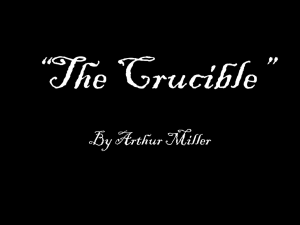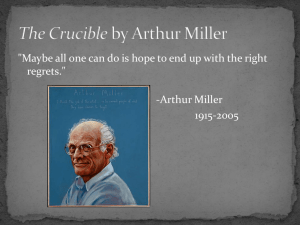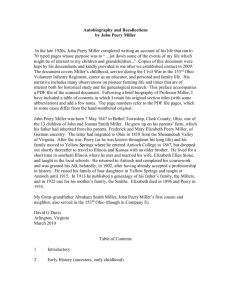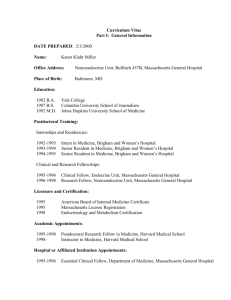In Canada - Way of Life Literature
advertisement
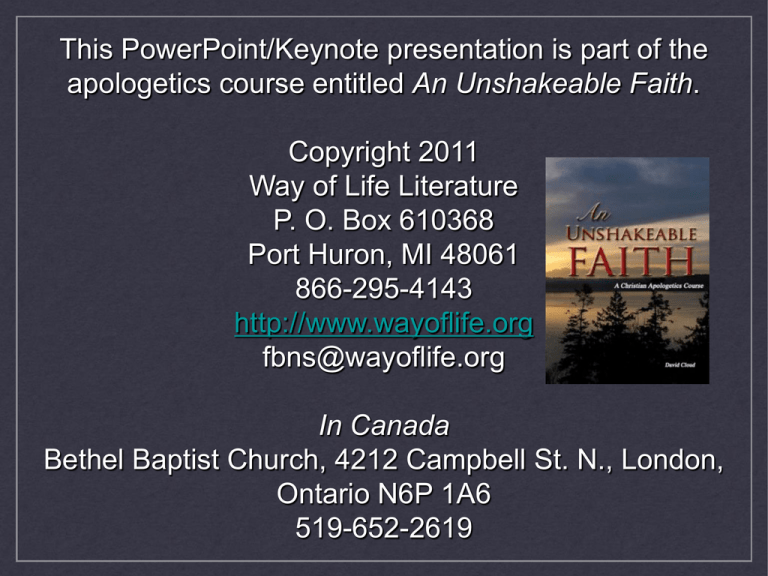
This PowerPoint/Keynote presentation is part of the apologetics course entitled An Unshakeable Faith. Copyright 2011 Way of Life Literature P. O. Box 610368 Port Huron, MI 48061 866-295-4143 http://www.wayoflife.org fbns@wayoflife.org In Canada Bethel Baptist Church, 4212 Campbell St. N., London, Ontario N6P 1A6 519-652-2619 Before viewing the slide presentations on evolution, the teacher should first present the introduction to the evolution section from the apologetics course “An Unshakeable Faith.” Icons of Evolution Fables in Textbooks and Museums Icons of Evolution are evidences that are commonly offered for evolution in textbooks and natural history museums. They should actually be called MYTHS OF EVOLUTION, because they provide zero scientific evidence for Darwinian evolution. In fact, they refute evolution! This is why we evolution cannot rightly be called a “theory.” “Evolution does not warrant being called a theory or a hypothesis.” David Stone, Ph.D. physics “A theory arises when a hypothesis has stood up to repeated tests under a wide variety of conditions and cannot be broken. Evolution warrants neither term. Evolution qualifies as a philosophical, even a religious idea, void of scientific support, and intended to replace biblical truth with stories.” David Stone, Ph.D. physics “For the time will come when they will not endure sound doctrine; but after their own lusts shall they heap to themselves teachers, having itching ears; and they shall turn away their ears from the truth, and shall be turned unto FABLES” 2 Timothy 4:3-4 The Miller Experiment and the primordial soup The Miller experiment was designed to prove that life could occur naturally in a “primordial soup.” Stanley Miller was a graduate student in the laboratory of Harold Urey, and their experiment was an attempt to validate a theory proposed by Alexander Oparin and J.B.S. Haldane, Marxists who wanted to disprove creationism. They theorized that the original atmosphere of the earth allowed the formation of organic compounds that could have been the “building blocks” of life. “As the gases circulated in the chamber, electric sparks, substituting for lightning, supplied energy to drive chemical reactions.” The experiment produced traces of amino acids, the building blocks of the proteins that are made in living cells. “The Miller-Urey experiment produced a variety of organic compounds, including amino acids” (Modern Biology, 1999). For half a century the Miller experiment has been used as proof of the evolution of life from non-life. New Scientist magazine proclaimed “In the beginning ... life assembled itself” (Feb. 27, 1969). 1. The Miller experiment is based on evolutionary assumptions. The Miller experiment is meaningless apart from evolutionary assumptions. It assumes a universe and an earth and a primordial soup in which life could have happened. But science has not proven that the universe and earth could have happened by naturalistic causes. Michael Denton, Ph.D. biochemistry “Considering the way the pre-biotic soup is referred to in so many discussions of the origin of life as an already established reality, it comes as something of a shock to realize that there is absolutely no positive evidence for its existence.” 2. Miller used the wrong materials. Since Miller conducted his experiment, scientists have determined that the atmosphere of the earth could not have been composed of the elements used in the experiment. Canadian geologists Erich Dimroth and Michael Kimberly wrote in 1979 that they saw no evidence “that an oxygen-free atmosphere has existed at any time.” British geologists Harry Clemmey and Nick Badham wrote in 1982 that “from the time of the earliest dated rocks ... earth had an oxygenic atmosphere.” “Geochemists soon reached a nearconsensus that the primitive atmosphere was nothing like the one Miller used” (Jonathan Wells, Icons of Evolution). Michael Pitman, who taught biology at Cambridge “Even the simple organic compounds-the smallest bricks of living material--would have crumbled as soon as they formed if oxygen were present” (Adam and Evolution). 3. Miller added unnatural elements to the experiment. The conditions of the experiment were not realistic. Under normal conditions hydrogen escapes into space, but Miller provided no way for it to escape. Under normal conditions any soluble organic products that formed would be quickly broken down, but Miller precluded this by building a trap to prevent such an occurrence. Gary Parker, Ed.D biology/geology “The same spark that puts amino acids together also tears them apart, and it’s much better at destroying. Miller knew this, so he trapped out the molecules he wanted. But that would be cheating, because you are supposed to say that this is how life arose without any intelligent design.” 4. Miller got the wrong results. Nothing living and selfreplicating was produced. Not even a protein was created. The main product of the Miller experiment was tar! Simon Morris called the product of such experiments “muck, goo and gunk.” Graham Cairns-Smith called them “grossly contaminated gunks.” The trace amounts of amino acids that were produced were both “left-handed” and “righthanded,” whereas any right-handed molecules prevent the creation of proteins. Stephen Grocott, Ph.D. organometallic chemistry “Sterilize a frog and put it in a sterile blender-buzzzzz. Seal up the mixture in a sterile container and leave it as long as you want.” Stephen Grocott “You won’t get life, despite the fact that you started with the best possible mixture of so-called precursors to life. Repeat the experiment a million times--in the sun, in the dark, with oxygen, without, with clay, without, with UV, without.” Stephen Grocott “It won’t make any difference. Thermodynamics clearly states that the mixture will decompose to simpler, lower energy, less information-containing molecules.” 5. Even if some type of life could be made in a test tube it would only prove that intelligence is required to create life. Michael Behe, Ph.D. in Biochemistry “Making the molecules of life by chemical processes outside of a cell is actually rather easy. Not only can amino acids and nucleotides be made, but a chemist can then take these and produce proteins and nucleic acids” (Darwin’s Black Box). Michael Behe “Most readers will quickly see the problem. There were no chemists four billion years ago. Neither were there any chemical supply houses, distillation flasks, nor any of the other devices that the modern chemist uses in his or her laboratory, and which are necessary to get good results.” 6. The modern science of genetics has falsified the idea of life arising from non-life. “The simplest organism capable of independent life, the prokaryote bacterial cell, is a masterpiece of miniaturized complexity which makes a spaceship seem rather low tech” (Phillip Johnson, Darwin on Trial). In Darwin’s day, the cell was thought to be a simple blob of protoplasm. Ernst Haeckel called it “a simple little lump of albuminous combination of carbon.” Therefore, it was not difficult for Haeckel to believe that life is constantly forming in the mud at the bottom of the sea. He called this “monera” and believed it formed the base of the “tree of life.” In “The History of Creation” (1868) he described the appearance, eating habits, and reproductive cycle of monera. “They consist entirely of shapeless, simple homogeneous matter ... a shapeless, mobile, little lump of mucus or slime ... organisms without organs” (Haeckel). He even gave monera the scientific name of Protamoeba primitivia. Today we know that the simplest living cell is more complicated than a modern city. The living cell is a living body with organs. It has blueprints, decoders, error checkers, quality control systems, power plants, power storage units, manufacturing plants, chemical plants, assembly lines, disposal units, trash compactors. The cell has a complex communication system, recycling centers, detoxification plants, transportation highways and tracks and tunnels, transportation vehicles, living walls with many types of oneway and two-way guarded, gated portals to the outside world, an external matrix to connect with other cells, and a host of other things. Michael Denton, Ph.D. biochemistry “Nearly every feature of our own advanced machines has its analogue in the cell: artificial languages and their decoding systems, memory banks for information storage and retrieval” (Evolution: A Theory in Crisis). “elegant control systems regulating the automated assembly of parts and components” (Evolution: A Theory in Crisis). “error fail-safe and proofreading devices utilized for quality control, assembly processes involving the principle of prefabrication and modular construction” (p. 328). The cell contains not only the blueprint of the plant or animal’s body and the information describing its every function but also the ability to actually fashion and operate it. Jerry Bergman, Ph.D. biology Even a “simple” E. coli bacteria has about 4,640,000 nucleotide base pairs, which code for 4,288 genes, each of which produces an enormously complex protein machine” (In Six Days, p. 25). The information in the DNA in one human cell is equivalent to a library of 4,000 books, each containing 500 pages. Yet it is so amazingly micro-engineered that all of the DNA from every person who has ever lived would weigh less than an aspirin tablet (Dr. Walt Brown, In the Beginning). The knowledge of these things has forced many scientists to the conclusion that life could not have arisen spontaneously. Henry Zuill, Ph.D. in biology “Complexity of the cell is now just too daunting to flippantly assert biochemical evolution to explain it ... And if cells could not originate naturally, then nothing else could” (In Six Days). Francis Crick, codiscoverer of DNA’s double helix structure “An honest man, armed with all the knowledge available to us now, could only state that in some sense, the origin of life appears at the moment to be almost a miracle” (Life Itself, 1981, p. 88). Sir Fred Hoyle “The notion that not only the biopolymers but the operating program of a living cell could be arrived at by chance in a primordial soup here on Earth is nonsense of a high order” (New Scientist, Nov. 19, 1981). 7. Every evolutionary origin of life theory has the same fatal flaw. Not one of the theories can realistically bridge the vast barrier from non-life to life, from inert chemicals to living self-replicating systems. This is true for RNA-first “theory,” the peptide “theory,” the deep sea vent “theory,” the iron-sulfur “theory,” the bubble “theory,” the clay “theory,” the autocatalysis “theory,” and all the others. The “theories” are more ridiculous than realistic. They amount to nothing more than a batch of “justso” stories. To propose a microsphere or a water bubble or a protobiont or a proteinoid or some such thing as the path toward life is meaningless, because none of these are living, self-replicating things. In such scenarios, you are still left on the non-living side of the chasm. These are as mythical as Haeckel’s Monera. In reality, evolutionists have failed entirely and miserably in their attempts to produce life in a test tube or even to demonstrate that such a thing is within the realm of possibility. An excellent discussion of the Miller experiment can be found in “Of Pandas and People.” The Miller experiment and every origin of life scenario only point out the bankruptcy of the doctrine and disqualify it from being a scientific theory or even a hypothesis. NOTE TO TEACHERS There are review questions and summaries to this material in the book An Unshakeable Faith. This presentation is abbreviated from the book “Seeing the Non-Existent: Evolution’s Myths and Hoaxes.” This book has about many more icons of evolution. This PowerPoint/Keynote presentation is part of the apologetics course entitled An Unshakeable Faith. Copyright 2011 Way of Life Literature P. O. Box 610368 Port Huron, MI 48061 866-295-4143 http://www.wayoflife.org fbns@wayoflife.org In Canada Bethel Baptist Church, 4212 Campbell St. N., London, Ontario N6P 1A6 519-652-2619


